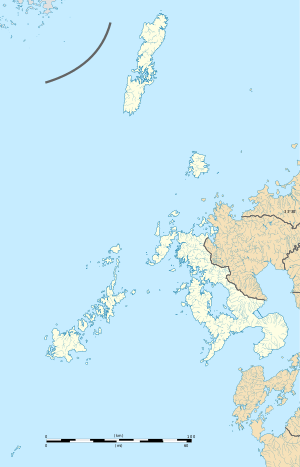Nagasaki Airport
Nagasaki Airport (長崎空港, Nagasaki Kūkō) (IATA: NGS, ICAO: RJFU) is an international airport located 4 km (2.5 mi) west of the railway station[2] in the city of Ōmura and 18 km (11 mi) north northeast of the Nagasaki railway station in the city of Nagasaki,[2] Nagasaki Prefecture, Japan.
Nagasaki Airport 長崎空港 Nagasaki Kūkō | |||||||||||||||
|---|---|---|---|---|---|---|---|---|---|---|---|---|---|---|---|
 | |||||||||||||||
| Summary | |||||||||||||||
| Airport type | Military/Public | ||||||||||||||
| Operator | Civil Aviation Bureau | ||||||||||||||
| Serves | Nagasaki, Japan | ||||||||||||||
| Location | Ōmura, Nagasaki | ||||||||||||||
| Hub for | Oriental Air Bridge | ||||||||||||||
| Elevation AMSL | 8 ft / 2 m | ||||||||||||||
| Coordinates | 32°55′01″N 129°54′49″E | ||||||||||||||
| Map | |||||||||||||||
 RJFU Location in Nagasaki Prefecture  RJFU Location in Japan | |||||||||||||||
| Runways | |||||||||||||||
| |||||||||||||||
| Statistics (2015) | |||||||||||||||
| |||||||||||||||
Source: Japanese Ministry of Land, Infrastructure, Transport and Tourism[1] | |||||||||||||||

The airport terminal and runway 14/32 are on an island, and the shorter runway 18/36 (now used by the Japan Maritime Self-Defense Force for helicopter flights) is on the mainland.
History
The mainland portion of the airport opened as a military aerodrome in 1923, and commenced civilian joint use as Omura Airport (大村空港) in 1955.
The current island runway and terminal opened on May 1, 1975,[3] and became Japan's first full-scale airport built over water.[4] Although Nagasaki is superficially similar to Japan's other island airports, Kansai International Airport, Kobe Airport, Kitakyushu Airport, and Chūbu Centrair International Airport, Nagasaki's island existed (in a radically different shape) before the airport was constructed. Constructing the airport required flattening the island's hills and forming landfill around its shore, expanding it from 0.9 to 1.54 km2 (0.35 to 0.59 sq mi). The island had 66 residents in 13 households, all of whom agreed to relocate so that the new airport could be built.[3]
Nagasaki's first international service, to Shanghai, commenced in September 1979.[3] The main runway was extended from 2,500 m to its current length in 1980, and the old mainland "A runway" (18/36) was abolished in 2010.[4]
Airlines and destinations
| Airlines | Destinations |
|---|---|
| All Nippon Airways | Nagoya–Centrair, Naha, Osaka–Itami, Tokyo–Haneda |
| China Eastern Airlines | Shanghai–Pudong |
| HK Express | Hong Kong[5] |
| Japan Airlines | Tokyo–Haneda |
| Japan Airlines operated by J-Air | Osaka–Itami |
| Jetstar Japan | Tokyo–Narita[6] |
| Oriental Air Bridge | Fukue, Iki, Tsushima |
| Peach | Osaka–Kansai, Tokyo–Narita |
| Skymark Airlines | Kobe, Tokyo–Haneda |
| Solaseed Air | Tokyo–Haneda |
Statistics
| Year | Total Passengers [7] |
|---|---|
| 1998 | 3,090,345 |
| 1999 | 3,056,828 |
| 2000 | 2,958,058 |
| 2001 | 2,846,646 |
| 2002 | 2,853,510 |
| 2003 | 2,834,289 |
| 2004 | 2,637,308 |
Ground transportation
Several companies provide scheduled bus service to the airport from Nagasaki, Shimabara, Sasebo, and other surrounding cities. Ferry operators provide service to Togitsu, Nagayo, and the Huis ten Bosch theme park.
References
- "Nagasaki Airport" (PDF). Japanese Ministry of Land, Infrastructure, Transport and Tourism. Archived from the original (PDF) on 21 October 2016. Retrieved 7 January 2017.
- "AIS JAPAN - Japan Aeronautical Information Service Center". aisjapan.mlit.go.jp. Archived from the original on May 17, 2016.
- "Airport Overview". Nagasaki Airport Building Co.,Ltd. Retrieved 2018-08-03.
- "大阪航空局_大阪航空局のご案内_管内空港の現況と出先機関_長崎空港". ocab.mlit.go.jp. Retrieved 2018-08-03.
- Ltd. 2019, UBM (UK). "HK Express plans Nagasaki launch in Jan 2019". Routesonline.
- Ltd. 2019, UBM (UK). "Jetstar Japan adds Nagasaki from Sep 2018". Routesonline.
- "Nagasaki Airport -About Nagasaki airport". Archived from the original on 2007-02-16. Retrieved 2007-02-19.
External links
| Wikimedia Commons has media related to Nagasaki Airport. |
- Nagasaki Airport
- Nagasaki Airport Guide from Japan Airlines
- Current weather for RJFU at NOAA/NWS
- Accident history for NGS at Aviation Safety Network